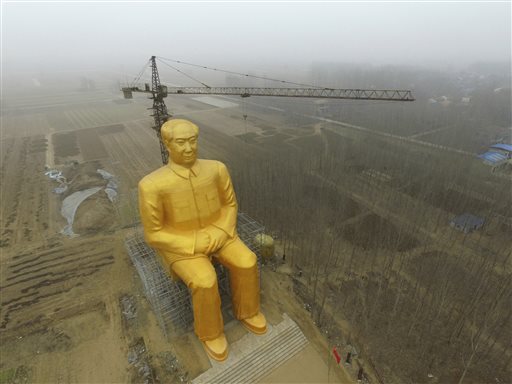
In this Monday, Jan. 4, 2016 file photo, a construction crane rises next to a giant gold-colored statue of former Chinese leader Mao Zedong in central China’s Henan province. The statue was demolished after it attracted heated social media discussion. Chinatopix via AP
BEIJING — A village in central China has abruptly demolished a statue of the country’s founder, Mao Zedong, after images of the structure covered in gold paint and looming 37 meters (120 feet) high over farmland attracted heated discussion on social media.
Although the official reason for the demolition is unknown, with even a high-level Communist Party newspaper struggling to explain the episode, the rise and fall of the Mao monument in rural Henan province highlights the political sensitivities in China surrounding a historical fi
gure alternatively revered and criticized by both the public and the government.
The project, reportedly financed by entrepreneurs, cost $460,000 and was near completion last week when it was nixed by local officials after images of the statue elicited mixed reactions on Chinese social media, and the story was picked up by domestic and international media.
The People’s Daily, the official Communist Party newspaper, said the statue may have lacked approval from cultural management authorities, though it also cited an official as saying that did not appear to be the reason. Local officials could not be reached for comment on Monday, and some agencies’ publicly listed telephone numbers appeared to be disconnected.
Since his death in 1976, Mao has been both revered as a founding father and blamed for political turmoil and disastrous economic policies that claimed millions of lives. Successors including Deng Xiaoping, China’s paramount leader during the 1980s, openly rebuked the cult of personality that had been built around Mao and warned cadres about the risk of overly concentrated influence.
Even as China’s current president, Xi Jinping, consolidates power to a degree that has drawn comparisons to Mao, he warned in a 2013 speech against “worshipping” revolutionary leaders without pointing out their mistakes.
Still, Mao, known as the “Great Helmsman,” has kept a firm grip on the imagination for a large swath of the population, particularly the dissatisfied, rural poor, drawing notice of central authorities.
Last month, the Global Times, a Communist Party tabloid, reported on the latest Mao statue to rise in rural northwestern China, where villagers sang revolutionary songs in a quasi-religious ceremony that featured “ecstatic dance” and a shamanistic figure brandishing a sword.
“Building Mao temples is not encouraged by the central government or local authorities,” the article noted.